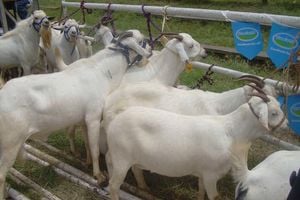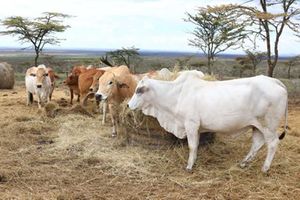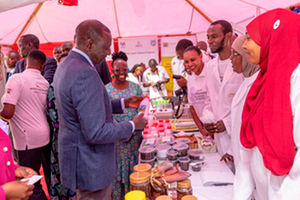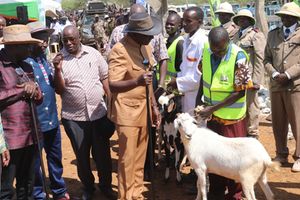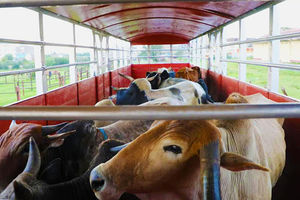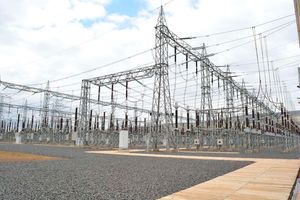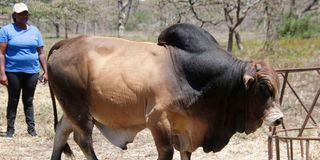
A veterinary inspects a boran bull at Sirima Cattle Quarantine centre inside Ol Pejeta Conservancy in Laikipia County.
I have been getting enquiries on how to start a beef feedlot. When I ask why people wish to start meat production, the answer is almost always that people cannot do without meat and supply appears to be falling as the population rises.
One person told me he felt that producing beef is easy as one only needs to give the cattle grass.
Though the statement is somehow correct, beef feedlot farming is not a walk in the park.
It is specialised with lots of science, management and marketing needed. It is also precision production where timelines must be followed diligently.
Separate from beef cattle rearing
First, beef feedlot farming is not the same as beef cattle rearing. Rearing is the production and reproduction of beef animals to maturity or to a feedlot age and weight.
Reproduction is the multiplication of animals through breeding while production is the growing of the animals to the target level such as feedlot weight, slaughter weight or breeding age and weight.
Where animals are fed primarily on pasture until their target state, that is plain production and usually takes long for the animals to attain the target state.
Feedlot animals, preferably bulls, are reared to a weight of 250 to 350kg for 15 to 24 months.
They are then recruited to a feedlot where they are fattened and finished for the market in 90 to 120 days.
Growing phase
The most economical time to keep animals in a feedlot is 90 days. Any extra day reduces profit of the farmer and goes into loss after 120 days. Animals entering a feedlot must be of good body frame that has ample room for packing meat.
They must have completed their growing phase. The feedlot farmer should not spend money adding the length of the bones of the animal because bones do not make good money.
A feedlot animal makes money for the farmer by building muscle and fat. The meat weight difference between the entry and exit weights is the new product the farmer creates.
To attain the targets set, the animal must have a well-formulated diet that gives minimal wastage and maximum utilisation to deposit fat and build muscle.
A total mixed ratio or TMR is advised. It must contain sufficient carbohydrate, protein, minerals and vitamins. Water is provided separately. This is where science comes in heavily in understanding and practising proper beef cattle nutrition.
The main feed ingredients for feedlot cattle are maize for carbohydrates, soya for protein and vitamin-mineral supplements for vitamins, hay for proper functioning of the digestive system and minerals.
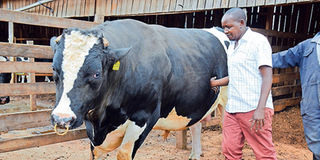
A livestock farmer inspects a bull.
Water is also a key component, with every animal consuming 40 to 70 litres of water a day, depending on the environment. High temperatures will result in the cattle consuming higher amounts of water.
The second thing to understand is that most feedlot farms buy animals from those who rear the animals.
It is, therefore, important for one to site a feedlot in an area where there is a good supply of feedlot cattle.
The breeds of cattle also matter as different breeds have different growth rates and market preference. The Zebu and Sahiwal breeds grow slower than European breeds.
However, most animals being put into feedlots are the Zebu, Sahiwal and their crosses and mixes. There is need for cattle producers to consider breeding European breeds and their crosses for feedlot purposes.
The choice of the feedlot site is another serious consideration in terms of land use, size of land, availability of expansion space, availability of water, electricity, security, roads and phone communication.
If utilities are lacking, one may end up having an uneconomical cost of production.
Beef feedlot farming is labour and capital intensive due to the level of care needed for the animals, construction, purchase of the animals and purchase or production of feeds.
When putting up a beef feedlot facility, one should do so in an area that is far from human habitation because it is a long-term project that must be operated for extended periods of time for it to make good return on investment.
Farm layout
A beef feedlot farm requires good design and layout to ensure efficiency in management of the animals and carrying out of logistical operations. Every animal in the feedlot requires nine to 15 square metres of space and 300mm of feeding space.
A wrong farm design could lead to poor feeding and diseases; and cause poor weight gains despite good feed formulation and feeding.
I recall visiting a feedlot where the animals stayed in mud pools whenever it rained.
I had been called to investigate frequent cases of pneumonia, lameness and poor weight gains in the animals. I diagnosed water-logging as the problem. This resulted in pneumonia and foot rot, which in turn led to poor appetite and low weight gain.
Finally, one has to choose to use wood or metal to construct the feedlot unit. Metal is normally preferred because it is more hygienic, has low maintenance and is durable.
Treated wood can also be used and fixed with folded metal rods rather than nails to minimise the chances of animals eating nails in the wood. The choice of wood or metal depends on the cost of the material at the time of construction.

